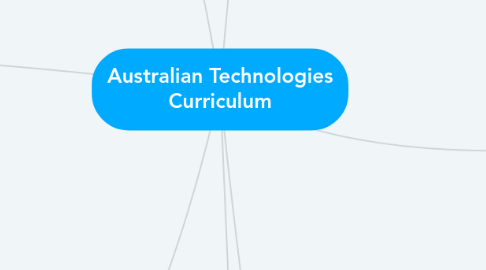
1. Student Diversity
1.1. Students with disability
1.1.1. Content Knowledge
1.1.1.1. Teachers may draw from content across the Pre Primary-10 scope and sequence according to the level of the individual students. Teachers may adjust learning foci using specific general capabilities according to student needs
1.1.2. Practical Skills
1.1.2.1. Students may use modified tools, materials, equipment and processes to create solutions and access the technologies curriculum on the same level as their classmates
1.2. EAL/D
1.2.1. Content and skills must be presented according to the SAE level of the individual student. Students may require more time to understand tasks and instructions. Instruction should be explicit.
1.3. Gifted and talented students
1.3.1. Teachers extend students by: -providing content from later years -providing additional content descriptors from current year -focusing on cross-curriculum priorities -focusing on specific general capabilities to promote higher order thinking -examining multiple local, state and territory curriculum -promoting independent inquiry, research and experimentation
2. Aims
2.1. Design and Technologies
2.1.1. Students design, produce and implement solutions to relevant technologies by creatively using a range of materials, systems, components, tools and equipment
2.1.2. Students understand the roles and importance of occupations with the technology industries
2.2. Digital Technologies
2.2.1. Students use processes which could be carried out by a digital system or computer to create solutions to digital situations
2.2.2. Students confidently communicate information and ideas using digital systems
2.2.3. Students consider and understand relationships in and between digital systems, and how these systems affect humanity
3. Cross-Curriculum Priorities
3.1. Aboriginal and Torres Strait Islander Histories and Cultures
3.1.1. Students apply range of traditional, contemporary and future technologies and practices to explore and understand cultural, community and economic capacity
3.2. Asia and Australia's Engagement with Asia
3.2.1. Enables students to understand the need for creative and cross-cultural solutions through examining the relationship between human activity and the environments of the Asia region
3.3. Sustainability
3.3.1. Focuses on the knowledge and skills required to produce desirable futures and design effective sustainable action through examining the balance between ethical, economic, environmental and social impacts
4. Cross-curricular Links
4.1. English
4.2. Mathematics
4.3. Science
4.4. Humanities and Social Sciences
4.5. The Arts
5. Subjects, Strands and Substrands
5.1. Subject: Design and Technologies
5.1.1. Strand 1: Knowledge and Understanding
5.1.1.1. Technologies and Society
5.1.1.2. Technologies Contexts
5.1.1.2.1. Engineering Principles and Systems
5.1.1.2.2. Food and Fibre Productions
5.1.1.2.3. Materials and Technologies Specialisations
5.1.1.2.4. Food Specialisations
5.1.2. Strand 2:Processes and Production Skills (Creating Solutions by:)
5.1.2.1. Investigating and Defining
5.1.2.2. Designing
5.1.2.3. Producing and Implementing
5.1.2.4. Evaluating
5.1.2.5. Collaborating and Managing
5.2. Subject: Digital Technologies
5.2.1. Strand 1: Knowledge and Understanding
5.2.1.1. Digital Systems
5.2.1.2. Representation of Data
5.2.2. Strand 2: Processes and Production Skills
5.2.2.1. Collecting, Managing and Analysing Data
5.2.2.2. Digital Implimentation
5.2.2.3. Creating Solutions by:
5.2.2.3.1. Investigating and Defining
5.2.2.3.2. Designing
5.2.2.3.3. Producing and Implementing
5.2.2.3.4. Evaluating
5.2.2.3.5. Collaborating and Managing
6. Bands
6.1. ACARA
6.1.1. Pre Primary - 2
6.1.2. 3 - 4
6.1.3. 5 - 6
6.2. SCSA
6.2.1. Pre Primary
6.2.2. 1
6.2.3. 2
6.2.4. 3
6.2.5. 4
6.2.6. 5
6.2.7. 6
7. General Capabilities
7.1. Literacy
7.1.1. Students develop literacy as they communicate ideas, concepts and proposals to a variety of audiences using language specific to technologies. Students use written, pictorial and computational representations.
7.2. Numeracy
7.2.1. Students use mathematical concepts of number, statistics and measurement as they move through the process of developing ideas to generating solutions. Computational thinking requires number, geometry, scale, proportion, measurement and volume
7.3. Information and Communication Technology
7.3.1. Digital Technologies: Students use computational thinking to automate solutions using algorithms.
7.3.2. Design and Technologies: Students develop key ICT concepts and skills as they use a range of software applications and hardware to create solutions.
7.4. Critical and Creative Thinking
7.4.1. Critical and creative thinking is developed as students consider possible, probable and preferred futures. They consider how current technologies could be better designed. They develop this capability a they imagine, develop and critically evaluate ideas.
7.5. Personal and Social Capability
7.5.1. Collaborative work develops personal and social capability in the technologies curriculum. Social awareness, empathy and respect are developed as students consider the impacts technologies have had and will have on communities.
7.6. Ethical Understanding
7.6.1. Creating, sharing and using technologies allows students to develop ethical understanding as they consider their role and responsibility in creating and using technologies, and the social, environmental, economic and ethical impact these technologies have.
7.7. Intercultural Understanding
7.7.1. Students examine the impact that technologies have on diverse communities at local, national, regional and global levels. The examine similarities and differences in technological impact between their own cultures and others.
